Investigating Historical Baseflow Characteristics and Variations in the Upper Yellow River Basin, China
Abstract
1. Introduction
2. Study Area
3. Materials and Methods
3.1. Data Availability
3.2. Lyne and Hollick Digital Filtering Method
3.3. Mann–Kendall Nonparametric Test
3.4. Rescaled Range Analysis Method
3.5. Wavelet Analysis
4. Results and Discussion
4.1. Spatiotemporal Characteristics of Baseflow and BFI
4.2. Abrupt Change in Baseflow
4.3. Periodic Characteristics and Trend Assessment of Baseflow
5. Conclusions
Author Contributions
Funding
Institutional Review Board Statement
Informed Consent Statement
Data Availability Statement
Conflicts of Interest
References
- Hall, F.R. Base-flow recessions—A review. Water Resour. Res. 1968, 4, 973–983. [Google Scholar] [CrossRef]
- Schilling, K.E.; Langel, R.J.; Wolter, C.F.; Arenas-Amado, A. Using baseflow to quantify diffuse groundwater recharge and drought at a regional scale. J. Hydrol. 2021, 602, 126765. [Google Scholar] [CrossRef]
- Wang, C.; Gomez-Velez, J.D.; Wilson, J.L. Dynamic coevolution of baseflow and multiscale groundwater flow system during prolonged droughts. J. Hydrol. 2022, 609, 127657. [Google Scholar] [CrossRef]
- Hao, L.; Su-Yun, L.I.; Sun, L.; Fang, D.; Qin, M.S. On Application of Different Base Flow Separation Methods in Qinhuai River Basin. J. Southwest China Norm. Univ. 2019, 44, 62–69. (In Chinese) [Google Scholar]
- Arciniega-Esparza, S.; Breña-Naranjo, J.A.; Hernández-Espriú, A.; Adrián, P.; Scanlon, B.R.; Nicot, J.; Young, M.H.; Wolaver, B.D.; Yamanaka, V.H.A. Baseflow recession analysis in a large shale play: Climate variability and anthropogenic alterations mask effects of hydraulic fracturing. J. Hydrol. 2017, 553, 160–171. [Google Scholar] [CrossRef]
- Miller, M.P.; Buto, S.G.; Susong, D.D.; David, D.; Rumsey, A. The importance of base flow in sustaining surface water flow in the Upper Colorado River Basin. Water Resour. Res. 2016, 52, 3547–3562. [Google Scholar] [CrossRef]
- Rumsey, C.A.; Miller, M.P.; Schwarz, G.E.; Hirsch, R.M.; Susong, D.D. The role of baseflow in dissolved solids delivery to streams in the Upper Colorado River Basin. Hydrol. Process. 2017, 31, 4705–4718. [Google Scholar] [CrossRef]
- Liu, Y.; Lin, Y.; Huo, Z.; Zhang, C.; Wang, C.; Xue, J.; Huang, G. Spatio-temporal variation of irrigation water requirements for wheat and maize in the Yellow River Basin, China, 1974–2017. Agric. Water Manag. 2022, 262, 107451. [Google Scholar] [CrossRef]
- Li, H.; Wang, W.; Fu, J.; Chen, Z.; Liu, Y. Quantifying the relative contribution of climate variability and human activities impacts on baseflow dynamics in the Tarim River Basin, Northwest China. J. Hydrol.-Reg. Stud. 2021, 36, 100853. [Google Scholar] [CrossRef]
- Mo, C.; Ruan, Y.; Xiao, X.; Lan, H.; Jin, J. Impact of climate change and human activities on the baseflow in a typical karst basin, Southwest China. Ecol. Indic. 2021, 126, 107628. [Google Scholar] [CrossRef]
- Wang, W.; Xu, J.; Qu, X.; Lin, D.; Yang, K. Current and future trends of low and high molecular weight polycyclic aromatic hydrocarbons in surface water and sediments of China: Insights from their long-term relationships between concentrations and emissions. Environ. Sci. Technol. 2022, 56, 3397–3406. [Google Scholar] [CrossRef]
- Qian, Y.P.; Jin, S.Y.; Jiang, X.H.; Lin, Y.P. Influence of variation of baseflow in the upper reaches of Lanzhou on water resources of Yellow River. Water Resour. Water Eng. 2004, 15, 19–23. [Google Scholar]
- Lei, Y.N.; Zhang, X.P.; Zhang, X.; Zhang, J.; Liu, E. Change trends and driving factors of base flow in Kuye River Catchment. Acta Ecol. Sin. 2013, 33, 1559–1568. (In Chinese) [Google Scholar]
- Chen, L.; Liu, C.; Yang, C.; Hao, F. Baseflow estimation of the source regions of the Yellow River. Geogr. Res. 2006, 25, 659–665. (In Chinese) [Google Scholar]
- Lei, G.; Zhang, H.; Chen, K.; Yu, Q. Spatial-temporal Evolution of River Baseflow in Northern Shaanxi. Adv. Earth Sci. 2015, 30, 802–811. (In Chinese) [Google Scholar]
- Li, Y.; Zhang, Q. Historical and predicted variations of baseflow in China’s Poyang Lake catchment. River Res. Appl. 2018, 34, 1286–1297. [Google Scholar] [CrossRef]
- Bosch, D.D.; Arnold, J.G.; Allen, P.G.; Lim, K.; Park, Y.S. Temporal variations in baseflow for the Little River experimental watershed in South Georgia, USA. J. Hydrol.-Reg. Stud. 2017, 10, 110–121. [Google Scholar] [CrossRef]
- Yu, X.; Guo, X.; Gao, H.; Zou, T. Upstream extension of a bottom-advected plume and its mechanism: The case of the Yellow River. J. Phys. Oceanogr. 2021, 51, 2351–2371. [Google Scholar] [CrossRef]
- Ma, X.; Zhang, M.; Huang, X.; Qian, M.A.; Pan, S. Characteristics of climate change and future trend in the upper Yellow River basin from 1960 to 2008. J. Arid Land Resour. Environ. 2012, 26, 17–23. [Google Scholar]
- Friedel, M.J.; Smith, M.E.; Chica, A.M.E.; Litke, D. Probable flood predictions in ungauged coastal basins of El Salvador. J. Hydrol. Eng. 2008, 13, 321–332. [Google Scholar] [CrossRef]
- Wu, L.; Huh, Y.; Qin, J.; Gu, D.; Lee, S.V.D. Chemical weathering in the Upper Huang He (Yellow River) draining the eastern Qinghai-Tibet Plateau. Geochim. Cosmochim. Acta 2005, 69, 5279–5294. [Google Scholar] [CrossRef]
- Lan, Y.C.; Wen, J.; Chang, J.; Xu, Y.; Lu, J. Possible change on the runoff in the upper Yellow River basin under global climate change. Sci. Cold Arid Reg. 2009, 1, 157–164. [Google Scholar]
- Yao, H.; Shi, C.; Shao, W.; Bai, J.; Yang, H. Impacts of climate change and human activities on runoff and sediment load of the Xiliugou basin in the Upper Yellow River. Adv. Meteorol. 2015, 2015, 481713. [Google Scholar] [CrossRef]
- Sloto, R.A.; Crouse, M.Y. HYSEP: A computer program for streamflow hydrograph separation and analysis. Water-Resour. Investig. Rep. 1996, 96, 4040. [Google Scholar]
- Hartmut, W. Baseflow recession and recharge as nonlinear storage processes. Hydrol. Process. 1999, 13, 715–726. [Google Scholar]
- Longobardi, A.; Villani, P.; Guida, D.; Cuomo, A. Hydro-geo-chemical streamflow analysis as a support for digital hydrograph filtering in a small, rainfall dominated, sandstone watershed. J. Hydrol. 2016, 539, 177–187. [Google Scholar] [CrossRef]
- Nathan, R.J.; McMahon, T.A. Evaluation of automated techniques for base flow and recession analyses. Water Resour. Res. 1990, 26, 1465–1473. [Google Scholar] [CrossRef]
- Ladson, A.R.; Brown, R.; Neal, B.; Nathan, R. A standard approach to baseflow separation using the Lyne and Hollick filter. Australas. J. Water Resour. 2013, 17, 25–34. [Google Scholar] [CrossRef]
- Zhao, W.; Li, Z.; Wang, Y. Separation and characteristics of base flow in the upper reaches of Heihe River Basin. South-North Water Transf. Water Sci. Technol. 2016, 14, 26–31. (In Chinese) [Google Scholar]
- Mann, H.B. Non-parametric test against trend. Econometrica 1945, 13, 245–259. [Google Scholar] [CrossRef]
- Kendall, M.G. Rank Correlation Methods; Charles Griffin: London, UK, 1975. [Google Scholar]
- Eckhardt, K. How to construct recursive digital filters for baseflow separation. Hydrol. Process. 2005, 19, 507–515. [Google Scholar] [CrossRef]
- Eckhardt, K. A comparison of baseflow indices, which were calculated with seven different baseflow separation methods. J. Hydrol. 2008, 352, 168–173. [Google Scholar] [CrossRef]
- Bassingthwaighte, J.B.; Raymond, G.M. Evaluating rescaled range analysis for time series. Ann. Biomed. Eng. 1994, 22, 432–444. [Google Scholar] [CrossRef]
- Mostafazadeh, R.; Moradzadeh, V.; Alaei, N.; Hazbavi, Z. Determining long-term memory using Hurst index for precipitation and discharge time series of selected stations in Ardabil Province. J. Water Soil Res. Conserv. 2022, 11, 113–131. [Google Scholar]
- Zhang, Y.; Hu, Y.; Zhang, F. The characteristics of natural streamflow in the upstream of the Yellow River. J. Arid Land Resour. Environ. 2017, 31, 104–109. [Google Scholar]
- Qian, Y.P.; Jiang, X.H.; Jin, S.Y.; Zhang, P.D. Analysis on the characteristic and variation of base flow in loessial plateau of the middle reaches of Huanghe River. J. Earth Sci. Environ. 2004, 26, 88–91. [Google Scholar]
- Wang, S.; Yan, Y.; Li, Y. Spatial and temporal variations of suspended sediment deposition in the alluvial reach of the upper Yellow River from 1952 to 2007. Catena 2012, 92, 30–37. [Google Scholar] [CrossRef]
- Yang, M.; Zhu, L.; Liu, J.; Zhang, Y.; Chen, X.; Zhou, B. Variation in generalized water resources effect of river base stream under the influence of vegetation recovery—Case of Beichuan river basin in upstream of Yellow River. J. Arid Land Resour. Environ. 2022, 36, 108–115. (In Chinese) [Google Scholar]
- Xie, J.; Xu, Y.P.; Wang, Y.; Gu, H.; Wang, F.; Pan, S. Influences of climatic variability and human activities on terrestrial water storage variations across the Yellow River basin in the recent decade. J. Hydrol. 2019, 579, 124218. [Google Scholar] [CrossRef]
- Miao, C.; Shi, W.; Chen, X.; Yang, L. Spatio-temporal variability of streamflow in the Yellow River: Possible causes and implications. Hydrol. Sci. J. 2012, 57, 1355–1367. [Google Scholar] [CrossRef][Green Version]
- Zhou, H.; Zhao, X.; Tang, Y.; Gu, S.; Zhou, L. Alpine grassland degradation and its control in the source region of the Yangtze and Yellow Rivers, China. Grasssl. Sci. 2005, 51, 191–203. [Google Scholar] [CrossRef]
- He, X.; Gao, Y.; Niu, J.; Zhao, Y. Landscape pattern changes under the impacts of urbanization in the Yellow River Wetland––taking Zhengzhou as an example. Procedia Environ. Sci. 2011, 10, 2165–2169. [Google Scholar] [CrossRef]
- Shi, L.; Cai, Z.; Ding, X.; Di, R.; Xiao, Q. What factors affect the level of green urbanization in the Yellow River Basin in the context of new-type urbanization? Sustainability 2020, 12, 2488. [Google Scholar] [CrossRef]
- Zhang, K.; Xie, X.; Zhu, B.; Meng, S.; Yao, Y. Unexpected groundwater recovery with decreasing agricultural irrigation in the Yellow River Basin. Agric. Water Manag. 2019, 213, 858–867. [Google Scholar] [CrossRef]
- Li, Y.; Zheng, C.; Qiu, X.; Yin, L.; Yang, Z. Distribution characteristics and risk assessment of heavy metal in drainage ditch of Yellow River irrigation region in Ningxia. China Rural Water Hydropower 2019, 5, 65–70. (In Chinese) [Google Scholar]
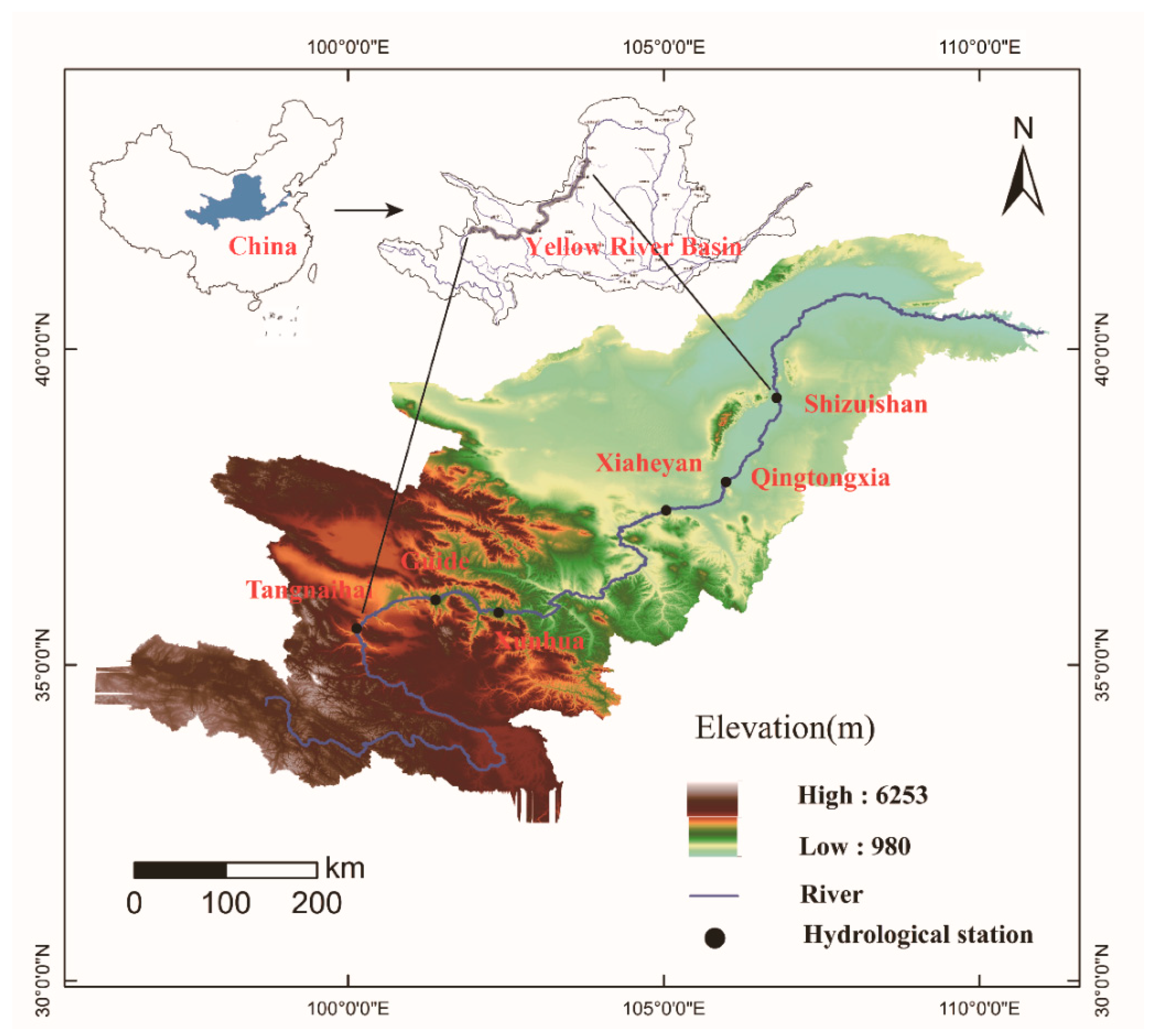
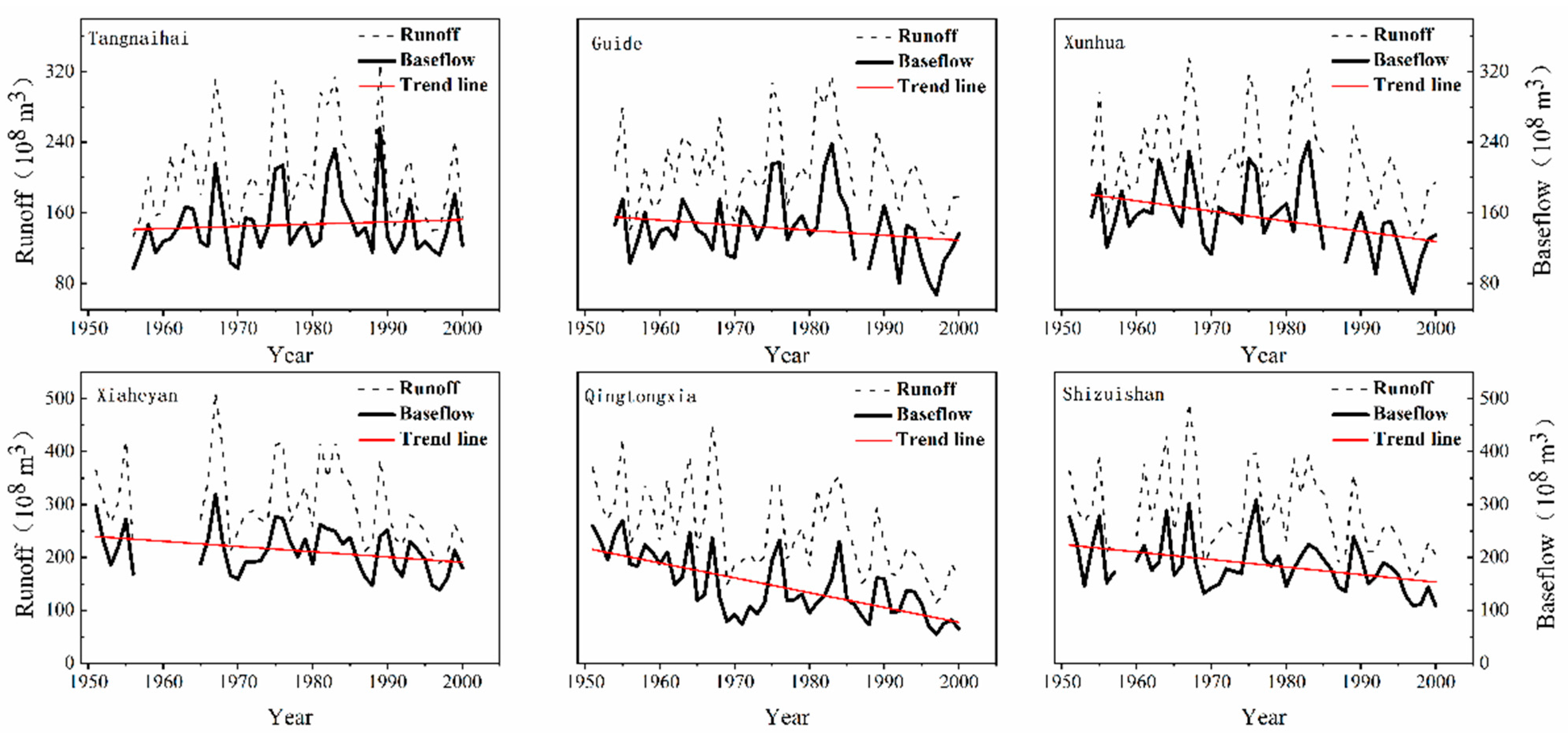
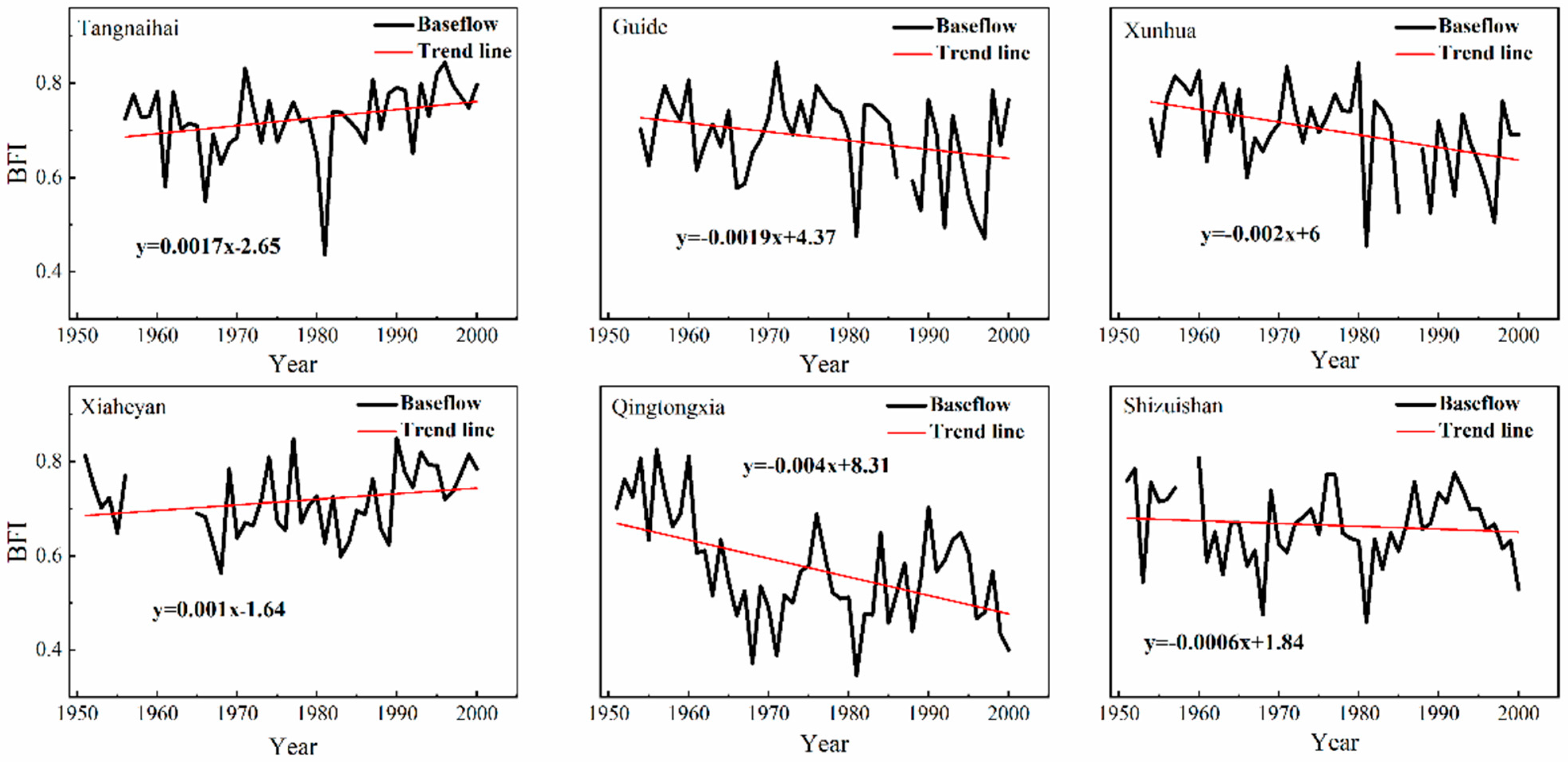
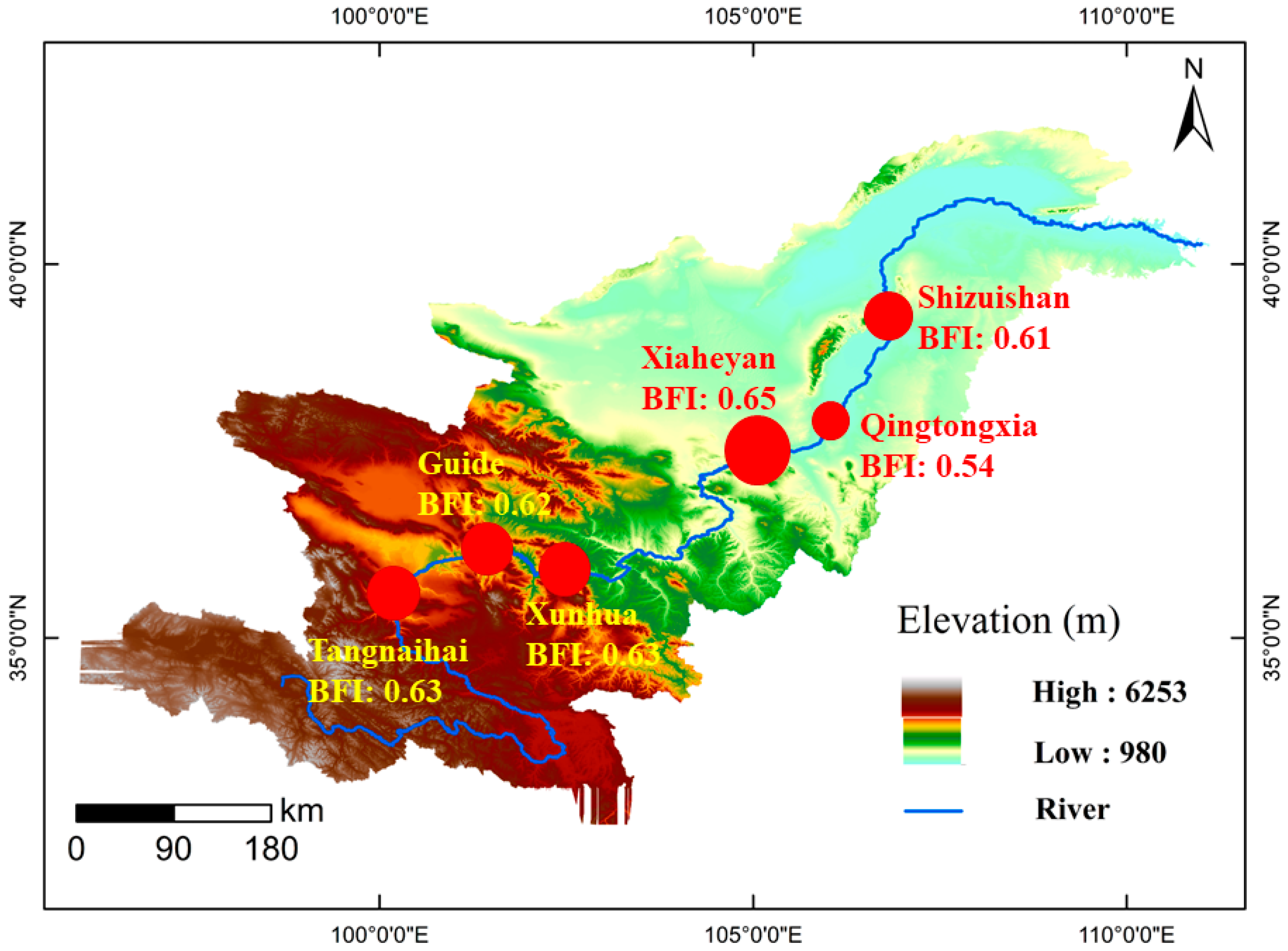
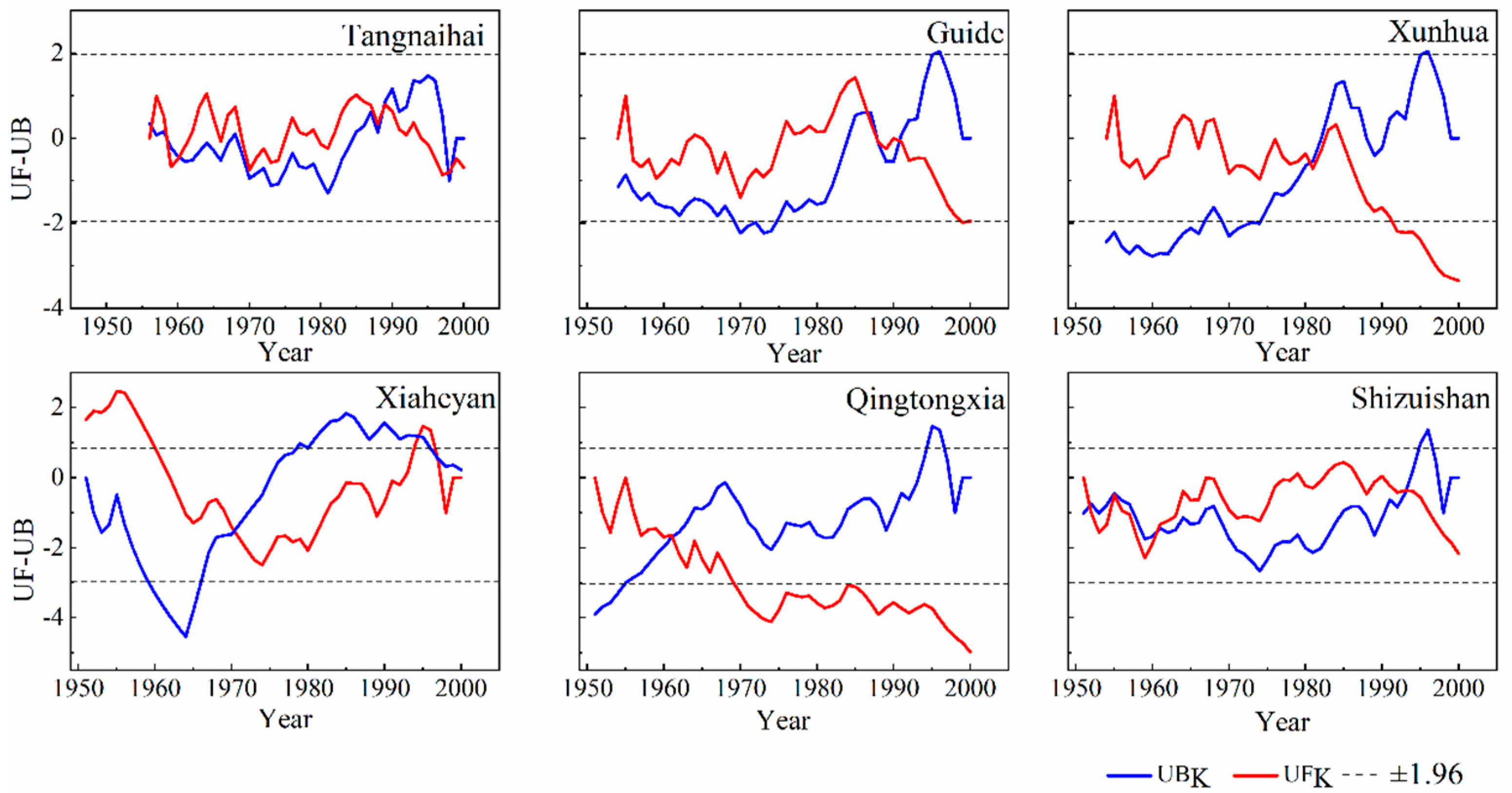
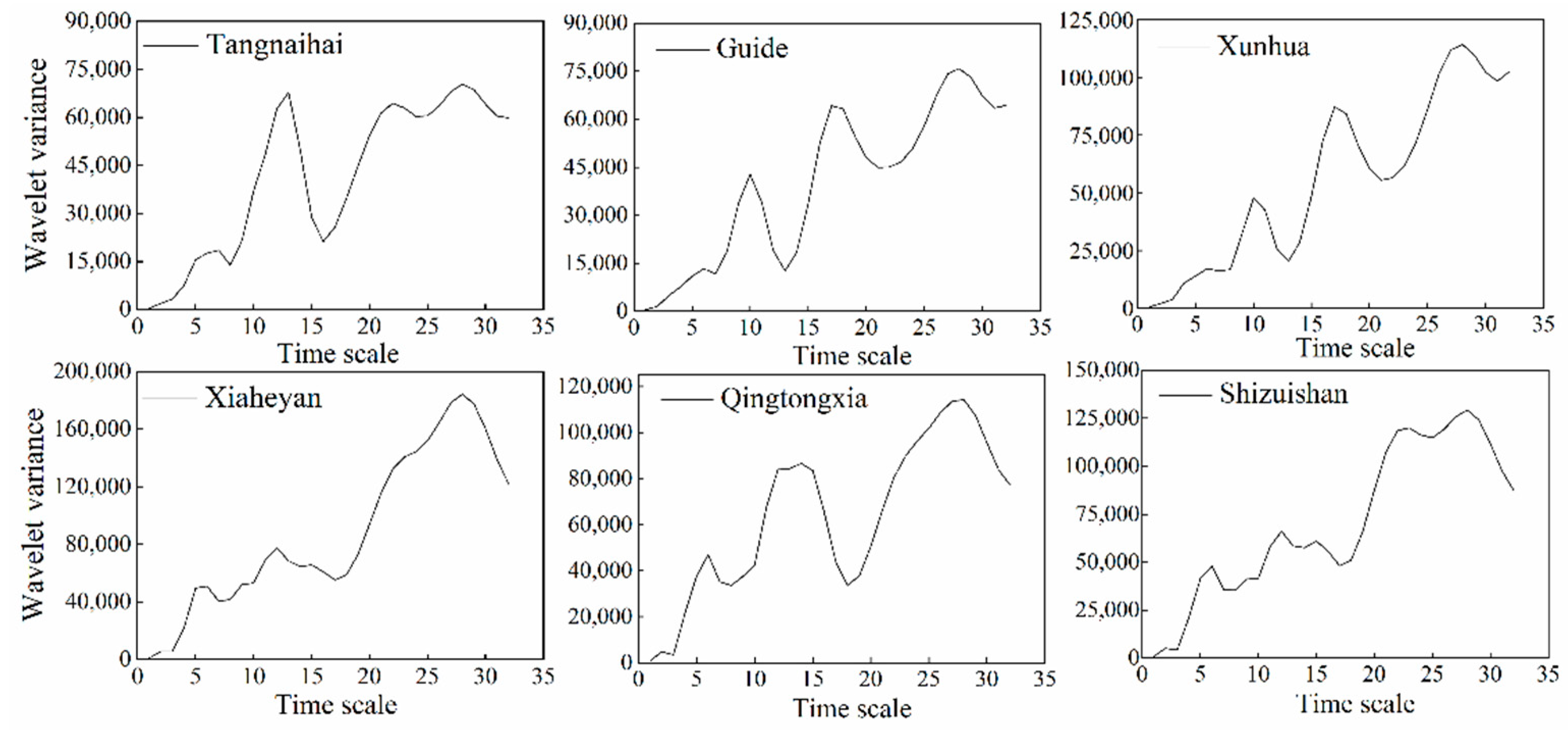
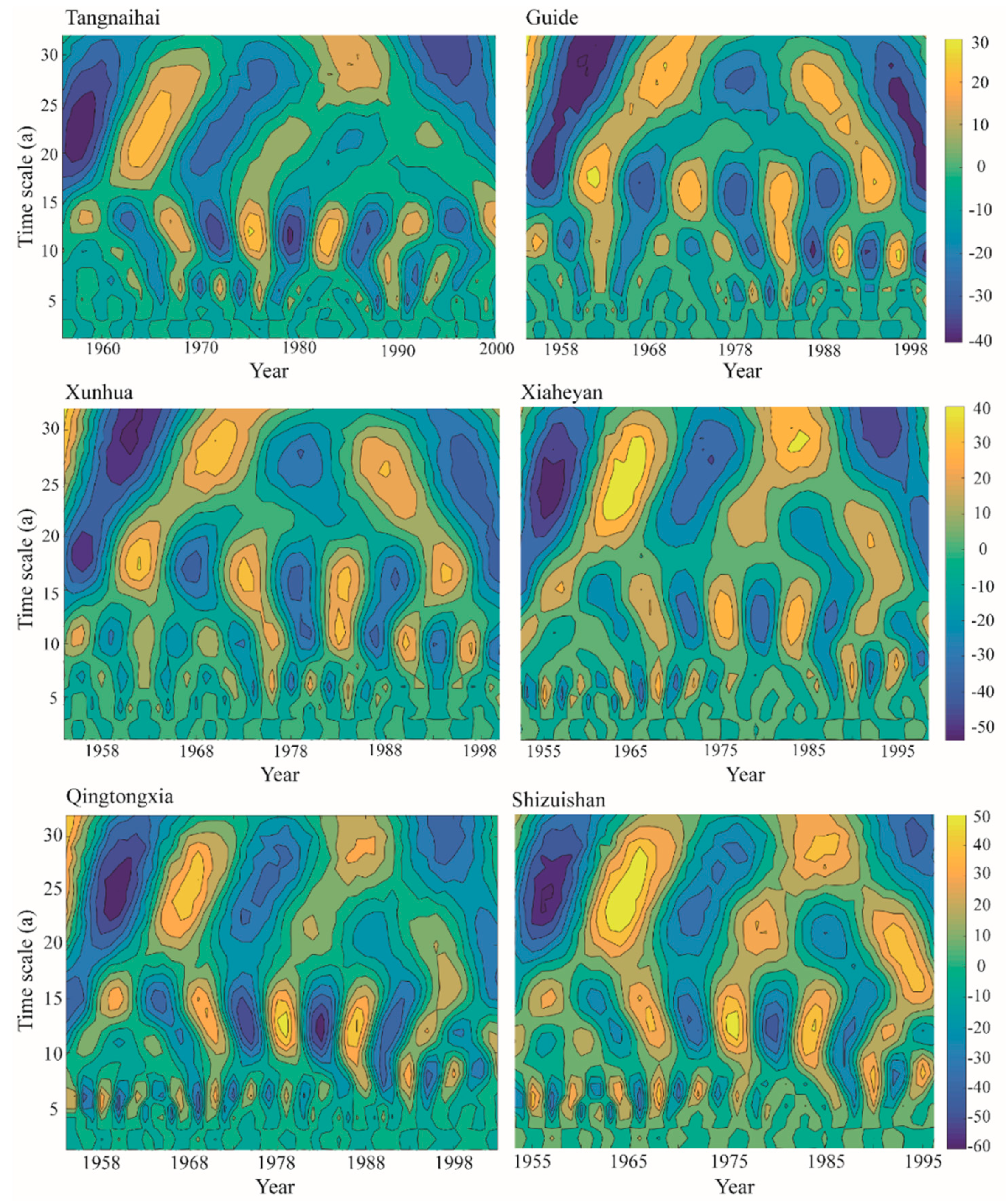
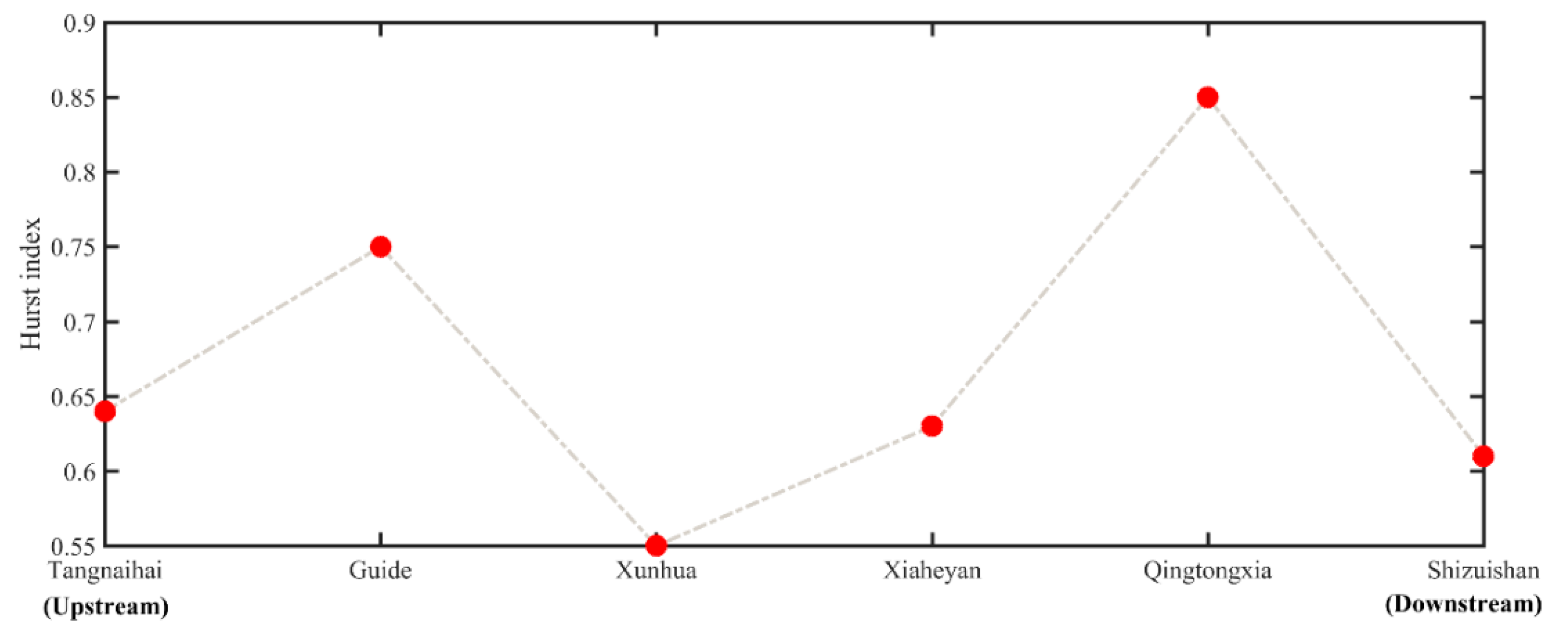
| Station | Geographical Location | Drainage Area (km2) | Series Length |
|---|---|---|---|
| Tangnaihai | 100°08′ E, 35°30′ N | 121,972 | 1956–2000 |
| Guide | 101°23′ E, 36°02′ N | 133,650 | 1954–2000 |
| Xunhua | 102°23′ E, 35°50′ N | 145,459 | 1954–2000 |
| Xiaheyan | 105°02′ E, 37°27′ N | 254,142 | 1951–2000 |
| Qingtongxia | 105°59′ E, 37°54′ N | 275,010 | 1951–2000 |
| Shizuishan | 106°47′ E, 39°14′ N | 209,146 | 1951–2000 |
| Station | Coefficient of Variation | Annual Baseflow (108 m3/year) | Extreme Ratio | ||
|---|---|---|---|---|---|
| Cv | Max. | Min. | Ave. | K | |
| Tangnaihai | 0.23 | 213.76 | 90.66 | 127.76 | 2.36 |
| Guide | 0.22 | 199.87 | 67.10 | 129.80 | 2.98 |
| Xunhua | 0.20 | 204.57 | 83.44 | 141.88 | 2.45 |
| Xiaheyan | 0.20 | 296.48 | 128.07 | 193.38 | 2.31 |
| Qingtongxia | 0.38 | 274.12 | 52.47 | 137.2 | 5.22 |
| Shizuishan | 0.23 | 258.80 | 95.31 | 170.21 | 2.71 |
Publisher’s Note: MDPI stays neutral with regard to jurisdictional claims in published maps and institutional affiliations. |
© 2022 by the authors. Licensee MDPI, Basel, Switzerland. This article is an open access article distributed under the terms and conditions of the Creative Commons Attribution (CC BY) license (https://creativecommons.org/licenses/by/4.0/).
Share and Cite
Zhao, G.; Kong, L.; Li, Y.; Xu, Y.; Li, Z. Investigating Historical Baseflow Characteristics and Variations in the Upper Yellow River Basin, China. Int. J. Environ. Res. Public Health 2022, 19, 9267. https://doi.org/10.3390/ijerph19159267
Zhao G, Kong L, Li Y, Xu Y, Li Z. Investigating Historical Baseflow Characteristics and Variations in the Upper Yellow River Basin, China. International Journal of Environmental Research and Public Health. 2022; 19(15):9267. https://doi.org/10.3390/ijerph19159267
Chicago/Turabian StyleZhao, Guizhang, Lingying Kong, Yunliang Li, Yuanzhi Xu, and Zhiping Li. 2022. "Investigating Historical Baseflow Characteristics and Variations in the Upper Yellow River Basin, China" International Journal of Environmental Research and Public Health 19, no. 15: 9267. https://doi.org/10.3390/ijerph19159267
APA StyleZhao, G., Kong, L., Li, Y., Xu, Y., & Li, Z. (2022). Investigating Historical Baseflow Characteristics and Variations in the Upper Yellow River Basin, China. International Journal of Environmental Research and Public Health, 19(15), 9267. https://doi.org/10.3390/ijerph19159267






